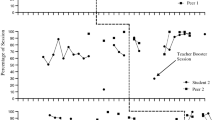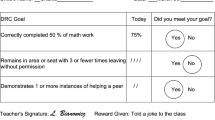Abstract
A critical component of multi-tiered systems of support is the incorporation of formative assessment, which supports school personnel in making data-based decisions about students’ responsiveness to interventions. Although a variety of assessments exist for monitoring the progress of students’ academic and behavioral functioning, the literature supporting progress monitoring of symptoms related to internalizing disorders, such as anxiety and depression, is less robust. Accordingly, the need for progress monitoring measures for internalizing symptoms for use within a school-based multi-tiered framework has been underscored. Thus, the purpose of this three-stage systematic review of the peer-reviewed literature was to (1) identify assessments that have been used to progress monitor the symptoms of children’ internalizing symptoms; (2) analyze their psychometric properties and basic characteristics; (3) and review their appropriateness for use as progress monitoring measures within a school setting. The results of the review identified 15 unique assessments that have been used to progress monitor internalizing symptoms in children, with eight of those assessments deemed practical for frequent use within a school setting. Implications of the results, limitations of the review, and future directions for research are discussed.
Similar content being viewed by others
References
*References marked with an asterisk indicate studies included in the systematic review
Ardoin, S. P., & Christ, T. J. (2009). Curriculum-based measurement of oral reading: Estimates of standard error when monitoring progress using alternate passage sets. School Psychology Review, 38, 266–283.
Angold, A., & Costello, E. J. (2001). Epidemiology of depression in children and adolescents. In I. Goodyer (Ed.), The depressed child and adolescent (2nd ed., pp. 143–178). Cambridge: Cambridge University Press.
*Bickman, L., Kelley, S. D., Breda, C., de Andrade, A. R., & Riemer, M. (2011). Effects of routine feedback to clinicians on mental health outcomes of youths: Results of a randomized trial. Psychiatric Services, 62(12), 1423–1429.
Briesch, A. M., Chafouleas, S. M., & Riley-Tillman, T. C. (2010). Generalizability and dependability of behavior assessment methods to estimate academic engagement: A comparison of systematic direct observation and direct behavior rating. School Psychology Review, 39(3), 408–421.
Burns, C. E. (2015). Does my program really make a difference? Program evaluation utilizing aggregate single-subject data. American Journal of Evaluation, 36(2), 191–203.
Carnevale, T. D. (2013). Universal adolescent depression prevention programs: A review. The Journal of School Nursing, 29(3), 181–195.
Center for Behavioral Health Statistics and Quality. (2015). Behavioral health trends in the United States: Results from the 2014 National Survey on Drug Use and Health. HHS Publication No. SMA 15-4927, NSDUH Series H-50. Retrieved from http://www.samhsa.gov/data/.
Chafouleas, S. M., Volpe, R. J., Gresham, F. M., & Cook, C. R. (2010). School-based behavioral assessment within problem-solving models: Current status and fu- ture directions. School Psychology Review, 39, 343–349.
*Chorpita, B. F., Reise, S., Weisz, J. R., Grubbs, K., Becker, K. D., & Krull, J. L. (2010). Evaluation of the brief problem checklist: Child and caregiver interviews to measure clinical progress. Journal of Consulting and Clinical Psychology, 78, 526–536.
Christ, T. J., Riley-Tillman, T. C., & Chafouleas, S. M. (2009). Foundation for the development and use of direct behavior rating (DBR) to assess and evaluate student behavior. Assessment for Effective Intervention, 34(4), 201–213.
Cohen, P., Cohen, J., Kasen, S., Velez, C. N., Hartmark, C., Johnson, J., et al. (1993). An epidemiological study of disorders in late childhood and adolescence—I. Age-and gender-specific prevalence. Journal of Child Psychology and Psychiatry, 34(6), 851–867.
Cooper, J. O., Heron, T. E., & Heward, W. L. (2007). Applied behavior analysis. Englewood Cliffs, NJ: Prentice Hall.
Costello, E. J., Egger, H., & Angold, A. (2005). 10-year research update review: The epidemiology of child and adolescent psychiatric disorders: I. Methods and public health burden. Journal of the American Academy of Child and Adolescent Psychiatry, 44(10), 972–986.
*Dart, E. H., Furlow, C. M., Collins, T. A., Brewer, E., Gresham, F. M., & Chenier, K. H. (2015). Peer-mediated check-in/check-out for students at-risk for internalizing disorders. School Psychology Quarterly, 30, 229–243.
Doll, B., Brehm, K., & Zucker, S. (2014). Resilient Classrooms. New York: Guilford Press.
*El Alaoui, S., Ljotsson, B., Hedman, E., Kaldo, V., Andersson, E., Ruck, C., et al. (2015). Predictors of symptomatic change and adherence in internet-based cognitive behaviour therapy for social anxiety disorder in routine psychiatric care. PLOS ONE, 1, 1–18.
*Forbes, E. E., Stepp, S. D., Dahl, R. E., Ryan, N. D., Whalen, D., Axelson, D. A., et al. (2012). Real-world affect and social context as predictors of treatment response in child and adolescent depression and anxiety: An ecological momentary assessment study. Journal of Child and Adolescent Psychopharmacology, 22(1), 37–47. https://doi.org/10.1089/cap.2011.0085.
*Gresham, F. M., Cook, C. R., Collins, T., Dart, E., Rasetshwane, K., Truelson, E., et al. (2010). Developing a change-sensitive brief behavior rating scale as a progress monitoring tool for social behavior: An example using the social skills rating system-teacher form. School Psychology Review, 39(3), 364–379.
*Hall, C. L., Moldavsky, M., Taylor, J., Marriott, M., Goodman, R., Sayal, K., et al. (2015). Innovations in practice: Piloting electronic session-by-session monitoring in child and adolescent mental health services: A preliminary study. Child and Adolescent Mental Health, 20(3), 171–174.
Hawken, L., Vincent, C., & Schumann, J. (2008). Response to intervention for social behavior: Challenges and Opportunities. Journal of Emotional and Behavioral Disorders, 16, 213–225.
Herman, K. C., Merrell, K., Reinke, W. M., & Tucker, C. M. (2004). The role of school psychology in preventing and treating depression. Psychology in the Schools, 41, 763–775.
Herzig-Anderson, K., Colognori, D., Fox, J. K., Stewart, C. E., & Warner, C. M. (2012). School-based anxiety treatments for children and adolescents. Child and Adolescent Psychiatric Clinics of North America, 21(3), 655–668. https://doi.org/10.1016/j.chc.2012.05.006.
*Howe, H., & Barnett, D. (2013). Accountability steps for highly reluctant speech: Tiered-services consultation in a head start classroom. Journal of Educational and Psychological Consultation, 23, 165–184. https://doi.org/10.1080/10474412.2013.813805.
Hunter, K. K., Chenier, J. S., & Gresham, F. M. (2014). Evaluation of check in/check out for students with internalizing behavior problems. Journal of Emotional and Behavioral Disorders, 22(3), 135–148.
*In-Albon, T., Meyer, A. H., & Schneider, S. (2013). Separation anxiety avoidance inventory-child and parent version: Psychometric properties and clinical utility in a clinical and school sample. Child Psychiatry and Human Development, 44, 689–697. https://doi.org/10.1007/s10578-013-0364-z.
*Kelley, S. D., Vides de Andrade, A. R., Bickman, L., & Robin, A. V. (2012). The session report form (SRF): Are clinicians addressing concerns reported by youth and caregivers? Administration and Policy in Mental Health and Mental Health Services Research, 39, 133–145. https://doi.org/10.1007/s10488-012-0415-y.
Kendall, P. C., Aschenbrand, S. G., & Hudson, J. (2003). Child-focused treatment of anxiety. In A. E. Kazdin & J. R. Weisz (Eds.), Evidence-Based Psychotherapies for Children and Adolescents (pp. 81–100). New York, NY: Guilford.
Kilgus, S. P., Reinke, W. M., & Jimerson, S. R. (2015). Understanding mental health intervention and assessment within a multi-tiered framework: Contemporary science, practice, and policy. School Psychology Quarterly, 30(2), 159–165.
Kovacs, M., & Devlin, B. (1998). Internalizing disorders in childhood. Journal of Child Psychology and Psychiatry, 39, 47–63.
*Lavigne, J. V., Cromley, T., Sprafkin, J., & Gadow, K. D. (2009). The child and adolescent symptom inventory-progress monitor: A brief diagnostic and statistical manual of mental disorders,—referenced parent-report scale for children and adolescents. Journal of Child and Adolescent Psychopharmacology, 19(3), 241–252.
Lewinsohn, P. M., Hops, H., Roberts, R. E., Seeley, J. R., & Andrews, J. A. (1993). Adolescent psychopathology: Prevalence and incidence of depression and other DSM-III-R disorders in high school students. Journal of Abnormal Psychology, 102, 133–144.
*Loades, M. E. (2014). Evidence-based practice in the face of complexity and comorbidity: A case study of an adolescent with Asperger’s syndrome, anxiety, depression, and chronic pain. Journal of Child and Adolescent Psychiatric Nursing, 28, 73–83. https://doi.org/10.1111/jcap.12108.
McIntosh, K., Ty, S. V., & Miller, L. D. (2014). Effects of school-wide positive behavioral interventions and supports on internalizing problems: Current evidence and future directions. Journal of Positive Behavior Interventions, 16(4), 209–218.
Miller, F. G., Cohen, D., Chafouleas, S. M., Riley-Tillman, T. C., Welsh, M. E., & Fabiano, G. A. (2014a). A comparison of measures to screen for social, emotional, and behavioral risk. School Psychology Quarterly, 30, 184–196.
Miller, F. G., Patwa, S. S., & Chafouleas, S. M. (2014b). Using direct behavior rating-single item scales to assess student behavior within multi-tiered systems of support. Journal of Special Education Leadership, 27(2), 76–85.
*Puddy, R. W., Boles, R. E., Dreyer, M. L., Maikranz, J., Roberts, M. C., & Vernberg, E. M. (2008). Demonstrating support for the formative and summative assessment paradigm in a school-based intensive mental health program. Journal of Child and Family Studies, 7, 253–263. https://doi.org/10.1007/s10826-007-9164-z.
Riley-Tillman, T. C., Chafouleas, S. M., Sassu, K. A., Chanese, J. A. M., & Glazer, A. D. (2008). Examining the agreement of direct behavior ratings and systematic direct observation data for on-task and disruptive behavior. Journal of Positive Behavior Interventions, 10(2), 136–143.
Rohde, P., Lewinsohn, P. M., & Seeley, J. R. (1994). Are adolescents changed by an episode of major depression? Journal of the American Academy of Child and Adolescent Psychiatry, 33(9), 1289–1298.
Shapiro, E. S. (2008). Best practices in setting progress monitoring goals for academic skill improvement. In A. Thomas & J. Grimes (Eds.), Best practices in school psychology IV (pp. 141–158). Bethesda, MD: National Association of School Psychologists.
Shinn, M. R. (2008). Best practices in Curriculum-Based Measurement and its use in a Problem-Solving model. In A. Thomas & J. Grimes (Eds.), Best practices in school psychology V (pp. 243–262). Bethesda, MD: National Association of School Psychologists.
Stark, K. D., Arora, P., & Funk, C. (2011a). CBT for youth depression: Implications for training school psychologists to become cognitive behavioral therapists. Psychology in the Schools, 48(3), 272–282.
Stark, K. D., Streusand, W., Arora, P., & Patel, P. (2011b). Treatment of childhood depression: The ACTION treatment program. In P. C. Kendall (Ed.), Child and adolescent therapy: Cognitive behavioral procedures (4th ed.). New York, NY: Guilford Press.
*Sukhodolsky, D. G., Gorman, B. S., Scahill, L., Findley, D., & McGuire, J. (2013). Exposure and response prevention with or without parent management training for children with obsessive-compulsive disorder complicated by disruptive behavior: A multiple-baseline across responses design study. Journal of Anxiety Disorders, 27, 298–305.
Sulkowski, M. L., Joyce, D. K., & Storch, E. A. (2012). Treating childhood anxiety in schools: Service delivery in a response to intervention paradigm. Journal of Child and Family Studies, 21(6), 938–947.
*Tsai, K. H., Moskowitz, A. L., Brown, T. E., Park, A. L., & Chorpita, B. F. (2016). Interpreting progress feedback to guide clinical decision-making in children’s mental health services. Administration and Policy in Mental Health and Mental Health Services Research, 43(2), 199–206.
*Vermeersch, D. A., Lambert, M. J., & Burlingame, G. M. (2000). Outcome questionnaire: Item sensitivity to change. Journal of Personality Assessment, 74(2), 242–261.
*von der Embse, N. P., Scott, E. C., & Kilgus, S. P. (2015a). Sensitivity to change and concurrent validity of direct behavior ratings for academic anxiety. School Psychology Quarterly, 30(2), 244–259.
von der Embse, N. P., Pendergast, L. L., Kilgus, S. P., & Eklund, K. R. (2015b). Evaluating the applied use of a mental health screener: Structural validity of the social, academic, and emotional behavior risk screener. Psychological Assessment, 28, 1265–1275.
Weist, M. D., & Murray, M. (2008). Advancing school mental health promotion globally. Advances in School Mental Health Promotion, 1(Sup1:Inaugural issue), 2–12.
Funding
This study was funded by the Society of School Psychology.
Author information
Authors and Affiliations
Corresponding author
Ethics declarations
Conflict of interest
The authors declared that they have no conflict of interest.
Ethical Approval
This article does not contain any studies with human participants or animals performed by any of the authors.
Rights and permissions
About this article
Cite this article
Dart, E.H., Arora, P.G., Collins, T.A. et al. Progress Monitoring Measures for Internalizing Symptoms: A Systematic Review of the Peer-Reviewed Literature. School Mental Health 11, 265–275 (2019). https://doi.org/10.1007/s12310-018-9299-7
Published:
Issue Date:
DOI: https://doi.org/10.1007/s12310-018-9299-7




